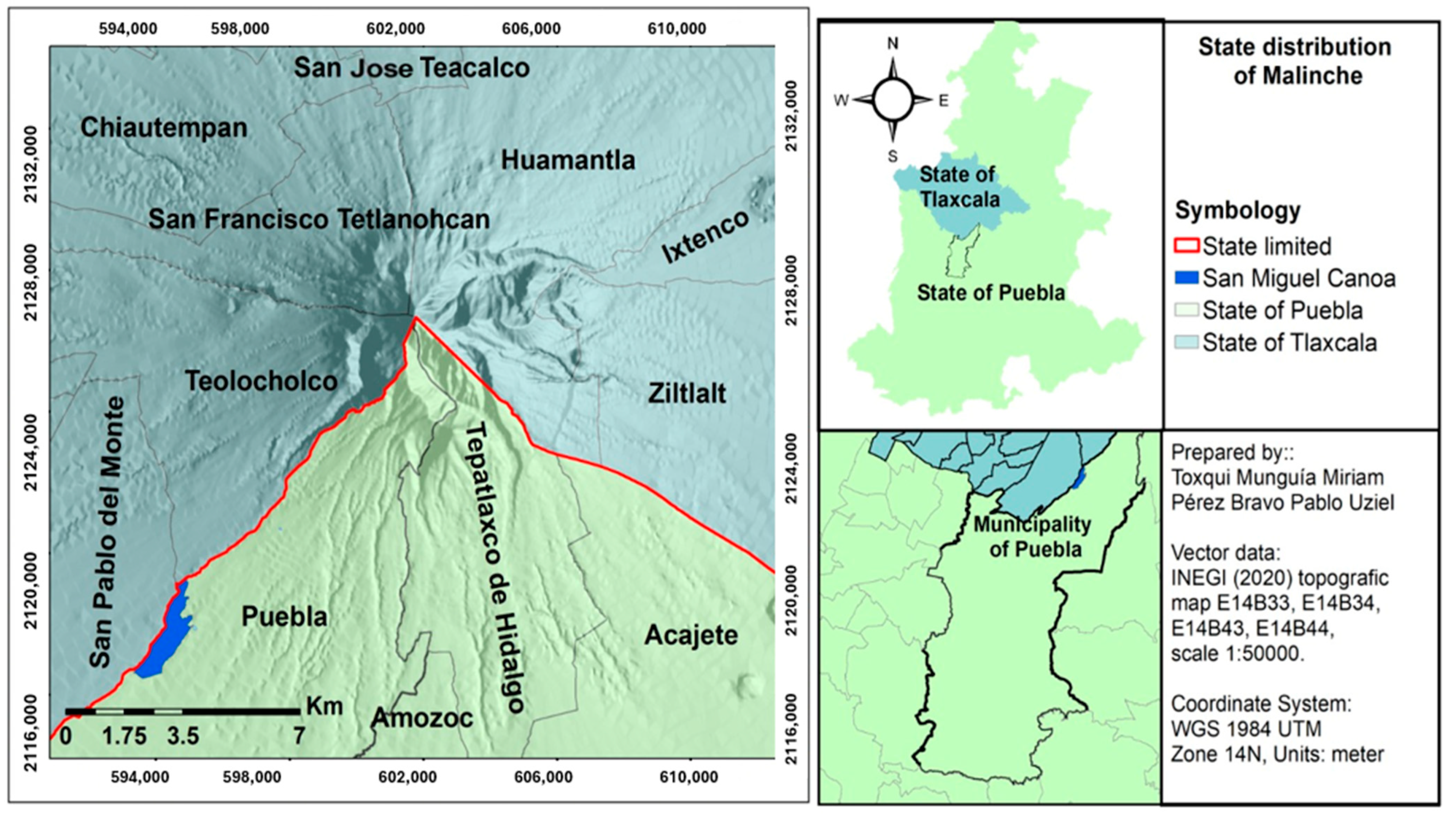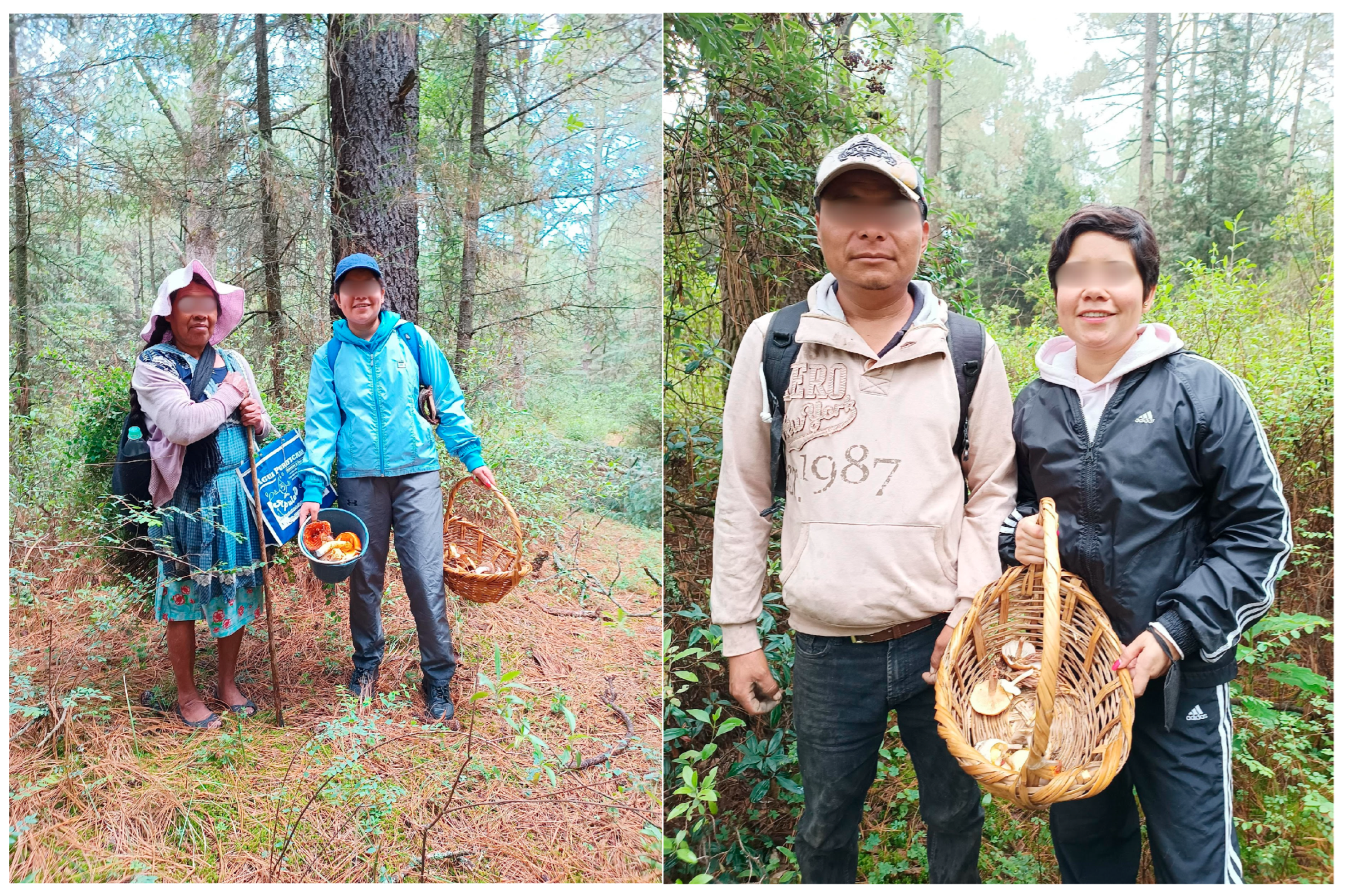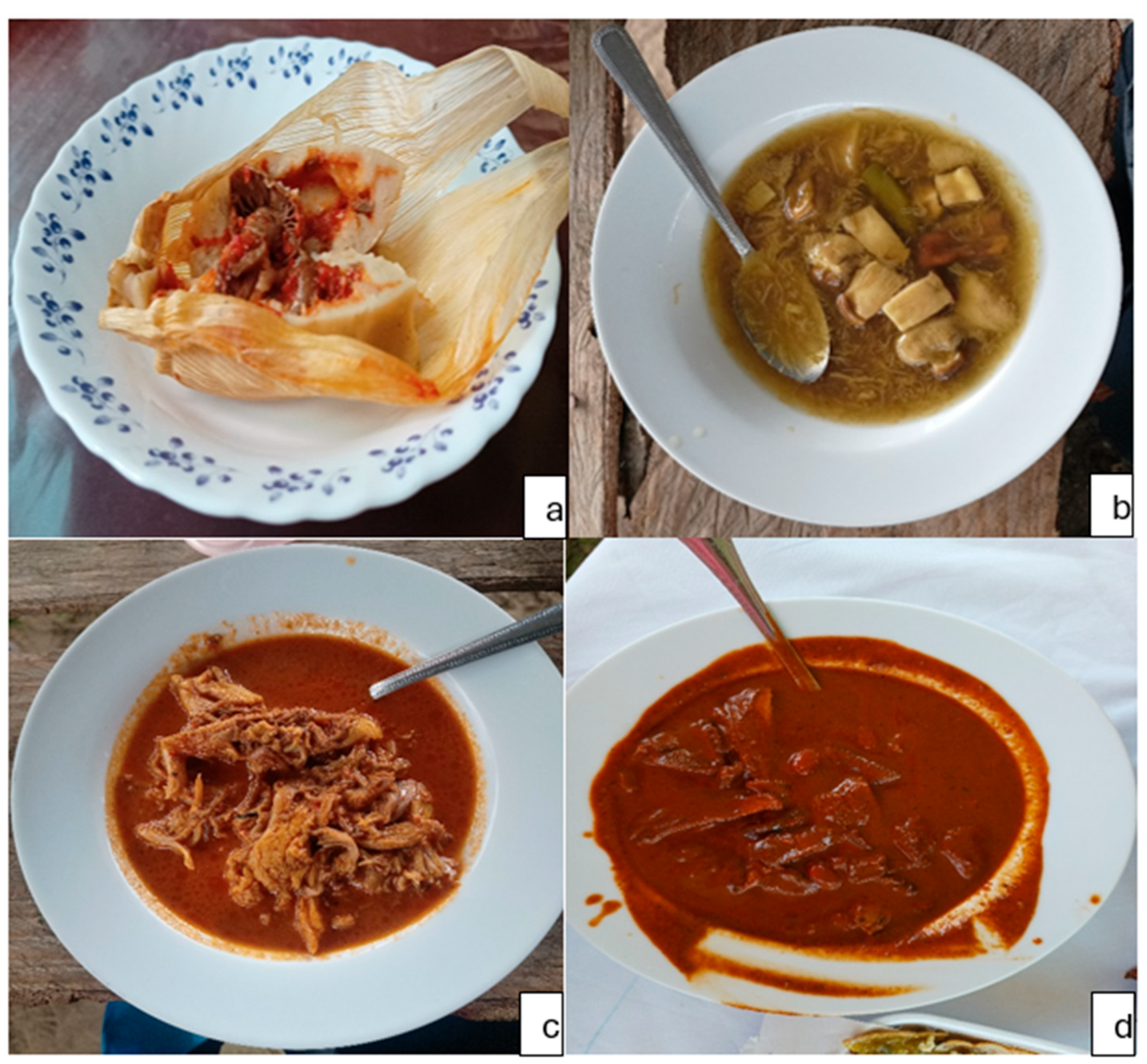Ethnomycology as a Biocultural Preservation Strategy for Wild Mushrooms in San Miguel Canoa, Puebla, México
Abstract
1. Introduction
2. Methods
2.1. Study Area
2.2. Wild Mushroom Fair in San Miguel Canoa
2.3. Ethnomycological Data Collection
2.3.1. Interviews
- Interviews for Qualified Community Informants: Administered to members of the Yolaltepetl collective and other key actors to identify families or individuals with extensive knowledge about macrofungi.
- Interviews for Key Residents: Documented harvesting practices, mushroom names in Nahuatl and Spanish, and traditional uses. The interviews were conducted in Spanish, but participants were asked to provide mushroom names in both languages for documentation. A bilingual (Spanish–Nahuatl) community member was present during the interviews.
2.3.2. Fieldwork
2.3.3. Data Analysis
2.3.4. Taxonomic Identification
3. Results
3.1. Diversity and Traditional Use of Wild Macrofungi in San Miguel Canoa
3.2. Etnomycological Knowledge and Ecological Factors
3.3. Collection and Socioeconomic Aspects
3.4. Cultural Implications: Mycogastronomy and Knowledge Transmission
3.5. Conservation and Cultural Promotion
4. Discussion
4.1. Mycological Knowledge and Intergenerational Transmission
4.2. Impacts of Land-Use Change and Deforestation
4.3. Worldviews and Sustainable Mushroom Management
4.4. Implications for Conservation and Public Policy
5. Conclusions
Author Contributions
Funding
Institutional Review Board Statement
Informed Consent Statement
Data Availability Statement
Acknowledgments
Conflicts of Interest
Abbreviations
| PNM | Malinche National Park |
| SMC | San Miguel Canoa |
References
- Herrera, J.R. The amazing kingdom of fungi. AV Perspect. 2001, 20, 275–281. [Google Scholar]
- Kityania, S.; Nath, R.; Das, S.; Nath, D.; Patra, J.K.; Das Talukdar, A. Fungi as Nutraceutical: Present to Future. In Applied Mycology: Entrepreneurship with Fungi; Shukla, A.C., Ed.; International Publishing Springer: Cham, Switzerland, 2022; pp. 187–202. [Google Scholar] [CrossRef]
- Reyes-López, R.C.; Montoya, A.; Kong, A.; Cruz-Campuzano, E.A.; Caballero-Nieto, J. Folk classification of wild mushrooms from San Isidro Buensuceso, Tlaxcala, Central Mexico. J. Ethnobiol. Ethnomed. 2020, 16, 53. [Google Scholar] [CrossRef]
- Torres-Gómez, M.; Garibay-Orijel, R.; Pérez-Salicrup, D.R.; Casas, A.; Guevara, M. Wild edible mushroom knowledge and use in five forest communities in central México. Can. J. For. Res. 2023, 53, 25–37. [Google Scholar] [CrossRef]
- Herrera, T. Fungi in Mexican Culture: Traditional Fermented Beverages and Foods, Hallucinogenic Mushrooms. Etnobiología 2005, 5, 108–116. [Google Scholar]
- Fuentes, A.M.; Origel, R.G.; Velasco, J.T.; Blanco, J.C. Situación actual de la Etnomicología en México y el Mundo. Etnobiología 2001, 1, 75–84. [Google Scholar]
- Carod-Artal, F.J. Hallucinogens in pre-Columbian Mesoamerican cultures. Neurología 2015, 30, 42–49. [Google Scholar] [CrossRef]
- González-Morales, A.; Ribas-Aparicio, R.M.; Burrola-Aguilar, C. Antioxidant activity of wild mushrooms traditionally consumed in central Mexico. Sci. Fungorum 2022, 52, e1410. [Google Scholar] [CrossRef]
- Malan, D.F.; Litta, A.L.; Kougbo, M.D.; Diop, A.L.; Kouassi, K.G. Wild edible plants in four Agni tribes of Central-east and Northeast of Côte d’Ivoire: A comparative study. Biodiversitas J. Biol. Divers. 2020, 21, 4896–4902. [Google Scholar] [CrossRef]
- Jalinik, M.; Pawłowicz, T.; Borowik, P.; Oszako, T. Mushroom Picking as a Special Form of Recreation and Tourism in Woodland Areas—A Case Study of Poland. Forests 2024, 15, 573. [Google Scholar] [CrossRef]
- Barrena, R.; Sánchez, M. Neophobia, personal consumer values and novel food acceptance. Food Qual. Prefer. 2013, 27, 72–84. [Google Scholar] [CrossRef]
- Mascarello, G.; Pinto, A.; Rizzoli, V.; Tiozzo, B.; Crovato, S.; Ravarotto, L. Ethnic Food Consumption in Italy: The Role of Food Neophobia and Openness to Different Cultures. Foods 2020, 9, 112. [Google Scholar] [CrossRef]
- Parra, F.; Casas, A. Origin and diffusion of domestication and agriculture in the New World. In Domestication in the American Continent, 1st ed.; UNAM/UNALM: Morelia, Mexico, 2016; pp. 159–187. [Google Scholar]
- Foley, R.A.; Lahr, M.M. The evolution of the diversity of cultures. Philos. Trans. R. Soc. B Biol. Sci. 2011, 366, 1080–1089. [Google Scholar] [CrossRef]
- Rangel-Landa, S.; Casas, A.; Rivera-Lozoya, E.; Torres-García, I.; Vallejo-Ramos, M. Ixcatec ethnoecology: Plant management and biocultural heritage in Oaxaca, Mexico. J. Ethnobiol. Ethnomed. 2016, 12, 30. [Google Scholar] [CrossRef]
- Si, A. Patterns in the transmission of traditional ecological knowledge: A case study from Arnhem Land, Australia. J. Ethnobiol. Ethnomed. 2020, 16, 52. [Google Scholar] [CrossRef]
- Freiwald, C.; Wolf, K.A.M.; Pugh, T.; Rand, A.J.; Fullagar, P.D. Early colonialism and population movement at the mission San Bernabé, Guatemala. Anc. Mesoam. 2020, 31, 543–553. [Google Scholar] [CrossRef]
- Bogadóttir, R. The Social Metabolism of Quiet Sustainability in the Faroe Islands. Sustainability 2020, 12, 735. [Google Scholar] [CrossRef]
- Boa, E. Wild Edible Fungi: Global Perspective on Their Use and Importance for the Population; Food and Agriculture Organization of the United Nations: Rome, Italy, 2005; p. 161. [Google Scholar]
- Parque Nacional La Malinche o Matlalcuéyatl. Available online: https://www.gob.mx/semarnat/articulos/parque-nacional-la-malinche-o-matlalcueyatl (accessed on 20 December 2024).
- Bello-Cervantes, E.; Caamal-Caamal, L.G.; Montoya-Esquivel, A.; Trejo-Vázquez, R.I.; Cifuentes-Blanco, J. Cultural importance of useful wild mushrooms in San Pedro Tlalcuapan, La Malinche National Park, Tlaxcala. Reg. Sustain. Dev. 2018, XVII, 78–105. [Google Scholar]
- Ramón-González, J.A.; Aguilar, A.G. Expansión urbana irregular urban expansion, land use change and environmental deterioration in the northern periphery of the Puebla-Tlaxcala Metropolitan Zone: The case of La Malinche National Park. Cuad. Geogr. Rev. Colomb. Geog. 2021, 30, 441–458. [Google Scholar] [CrossRef]
- López-Téllez, M.C.; Campos-Cabral, V.; Ramírez-Carmona, G. La Malinche National Park and the social ecological impact of its decree as a Natural Protected Area. Reg. Sustain. Dev. 2019, XIX, 10–30. [Google Scholar]
- Valencia, E.L.; Silverio, F.Z. San Miguel Canoa, pueblo urbano. Topofilia 2019, 19, 35–45. [Google Scholar]
- Martínez-Arellano, S.; Rapo-Míguez, S.E. The relationship between the city of Puebla, La Malinche and San Miguel Canoa: Conformation and dispute of the territory. Reg. Sustain. Dev. 2018, XVII, 141–163. [Google Scholar]
- Parker, C.; Scott, S.; Geddes, A. Snowball Sampling. Res. Methods Found. 2019, 1. [Google Scholar]
- García, S.C.; Gil, E.R.; Blanco, J.C. Macrofungi Guide of the Agua Blanca State Park, 1st ed.; Juárez University of Tabasco: Centro Tabasco, Mexico, 2013; Volume 1. [Google Scholar] [CrossRef]
- López-Ramírez, M.A. Edible Mushroom Mycelium Production Manual, 1st ed.; Veracruzana University: Xalapa, Mexico, 2016. [Google Scholar]
- Díaz-Barriga, H. Edible and Poisonous Mushrooms of the Lake Pátzcuaro Basin, Michoacán; Michoacan University of San Nicolás de Hidalgo: Morelia, Mexico, 1992; p. 148. [Google Scholar]
- Díaz-Barriga Vega, H. Poisonous, Medicinal, and Wood-Decaying Macromycete Fungi of the Monarch Butterfly Biosphere Reserve, Sierra Chincua, Michoacán, Mexico, 1st ed.; 1st reprint; Fundación Produce, Michoacán State Forest Commission: Mexico, 2011; p. 310. [Google Scholar]
- Guzmán, G. Identification of Edible, Poisonous, Hallucinogenic, and Wood-Destroying Fungi, 5th ed.; Institute of Ecology INECOL: Limusa, Mexico, 1990; p. 458. [Google Scholar]
- Kic, P. Mushroom drying characteristics and changes of colour. Eng. Rural Dev. 2018, 23, 432–438. [Google Scholar] [CrossRef]
- Ruan-Soto, F.; Sánchez, J.E.; Noyola-Méndez, L.; Ramírez-Terrazo, A.; Garibay-Orijel, R.; Cifuentes, J. Aprovechamiento de los hongos comestibles en México: Una tradición que trasciende al futuro. Lilloa 2025, 62, 181–202. [Google Scholar] [CrossRef]
- Pérez-Moreno, J.; Guerin-Laguette, A.; Rinaldi, A.C.; Yu, F.; Verbeken, A.; Hernández-Santiago, F.; Martínez-Reyes, M. Edible mycorrhizal fungi of the world: What is their role in forest sustainability, food security, biocultural conservation and climate change? Plants People Planet 2021, 3, 471–490. [Google Scholar] [CrossRef]
- López-García, A.; Gómez-Hernández, M.; Gándara, E. Variation in traditional knowledge of culturally important macromycete species among three indigenous communities of Oaxaca, Mexico. J. Ethnobiol. Ethnomed. 2024, 20, 38. [Google Scholar] [CrossRef]
- Rico-Carrillo, R.E.; Cardona-Castaño, J.C.; Acevedo, A.Y.R.; Montoya-Esquivel, A.; Cruz-Campuzano, E.A. Gestión participativa y conocimiento local de los hongos silvestres, comunidad de San Pedro Tlalcuapan, Tlaxcala-México. Rev. Científica Del. Amazon. 2024, 7, 74–85. [Google Scholar] [CrossRef]
- Schunko, C.; Li, X.; Klappoth, B.; Lesi, F.; Porcher, V.; Porcuna-Ferrer, A.; Reyes-García, V. Local communities’ perceptions of wild edible plant and mushroom change: A systematic review. Glob. Food Secur. 2022, 32, 100601. [Google Scholar] [CrossRef]
- Marín-Castro, M.; Silva-Díaz, V.; Linares-Fleites, G.; Castagnino, A.; Ticante-Roldán, J. The biodiversity of ectomycorrhizal fungi and its importance for forest conservation in the Puebla area of the Malintzi National Park. In The Biodiversity of Ectomycorrhizal Fungi; Zea Books: Lincoln, NE, USA, 2015. [Google Scholar]
- Niego, A.G.T.; Rapior, S.; Thongklang, N.; Raspé, O.; Hyde, K.D.; Mortimer, P. Reviewing the contributions of macrofungi to forest ecosystem processes and services. Fungal Biol. Rev. 2023, 44, 100294. [Google Scholar] [CrossRef]
- Haro-Luna, M.X.; Vázquez, J.B.; Ruan-Soto, F.; Guzmán-Dávalos, L. Sociocultural drivers of mycological knowledge: Insights from Wixarika and Mestizo groups in western Mexico. J. Ethnobiol. Ethnomed. 2022, 18, 68. [Google Scholar] [CrossRef]
- Escarabajal Gómez, M. The Food Use of Wild Mushrooms in San Pedro Tlanixco, Tenango del Valle, State of Mexico. Bachelor’s Thesis, Autonomous University of the State of Mexico, Toluca, Mexico, 2024. [Google Scholar]
- Torres-Gómez, M.; Gómez-Peralta, M.; Vázquez-Marrufo, G. Wild mushroom consumption in the P’urhépecha Plateau at Michoacán, México: Social, ethnomycological and nutritional issues. J. Ethn. Foods 2023, 10, 4. [Google Scholar] [CrossRef]
- Molina-Castillo, S.; Espinoza-Ortega, A.; Thomé-Ortiz, H.; Moctezuma-Pérez, S. Gastronomic diversity of wild edible mushrooms in the Mexican cuisine. Int. J. Gastron. Food Sci. 2023, 31, 100652. [Google Scholar] [CrossRef]
- Fontana, N.M.; Pasailiuk, M.V.; Pohribnyi, O. Traditional ecological knowledge to traditional foods: The path to maintaining food sovereignty in Hutsulshchyna. Front. Sustain. Food Syst. 2022, 6, 720757. [Google Scholar] [CrossRef]
- Nic Lughadha, E.; Bachman, S.P.; Leão, T.C.C.; Forest, F.; Halley, J.M.; Moat, J.; Acedo, C.; Bacon, K.L.; Brewer, R.F.A.; Gâteblé, G.; et al. Extinction risk and threats to plants and fungi. Plants People Planet 2020, 2, 389–408. [Google Scholar] [CrossRef]
- Zamorano, S.M.B.; Avilés, R.P.; Flores, J.L.A.; García, G.A.; Espejel, B.O.; Ramírez, M.M. Patrimonio biocultural como alternativa sustentable en el Parque Nacional Malintzin, Tlaxcala, México. RD-ICUAP 2021, 7, 156–173. [Google Scholar] [CrossRef]
- Estrada, E.M.; Suárez, M.E.; Cuba, I.M.M.; Arce, W.A.; Rocabado, D.; Lechner, B.E. Estado actual de conocimiento, empleo y comercialización de hongos alimenticios silvestres y cultivados en Bolivia. Lilloa 2025, 62, 49–78. [Google Scholar] [CrossRef]
- Ramírez-Carbajal, E.; Martínez-Reyes, M.; Ayala-Vásquez, O.; Fabiola, R.; Reyes, M.L.; Hernández-Santiago, F.; Villafranco, M.R.; Yu, F.; Pérez-Moreno, J. Revitalizing endangered mycocultural heritage in Mesoamerica: The case of the Tlahuica-Pjiekakjoo culture. Plants People Planet 2025, 8–9. [Google Scholar] [CrossRef]



| Scientific Name | Family | Common Name | Nahuatl Name | Additional Information | Use |
|---|---|---|---|---|---|
| Amanita bassi Guzmán & Ram.-Guill | Amanitaceae | Flor de calabaza | Ayoxochitl | ayotli = squash; xochitl = flower. | C |
| Amanita rubescens Pers.sensu lato | Amanitaceae | Mantecada | - | - | C |
| Boletus edulis sl Toro | Boletaceae | Pante | Xotoma | Xitomat l = large, red, and large tomato. | C |
| Calvatia cyanthiformis (Bosc) Morgan | Agaricaceae | Huevitos | Xiteboro | - | C |
| Hellvella lacunosa Afzel | Helvellaceae | Oreja de conejo | Gachupí | - | C |
| Infundibulicybe gibba (Pers.) Harmaja (grupo) | Tricholomataceae | Izquilo | izquilonanacatl | izquitl = roasted corn; aromatic flower. | C |
| Ramaria flava sl (Schaeff.) Quél | Gomphaceae | Coral | Xelhuas | xelhuatzi = broom xolhuatztli = small brush. | C |
| Russula delica Fr. | Russulaceae | Trompa cochino | Cuatecax | cuatlil = head; tecaxitl o tecaxitli = grinding stone. | C |
| Suillus brevipes (Peck) Kuntze | Suillaceae | Poposo | Popozonallot | popozonallot = foam. | C |
| Turbinellus floccosus (Schwein) Earle | Gomphaceae | Trompeta | Tlapitzal | tlapitzalli = trumpet. | C |
| Scientific Name | Priority Species for Consumption | Income (1000 g/dollar) |
|---|---|---|
| Amanita bassi Guzmán & Ram.-Guill | III | 10–12 |
| Amanita rubescens Pers.sensu lato | II | 5–7 |
| Boletus edulis sl Toro | III | 10–12 |
| Calvatia cyanthiformis (Bosc) Morgan | I | 3–5 |
| Hellvella lacunosa Afzel | III | 8–10 |
| Infundibulicybe gibba (Pers.) Harmaja (grupo) | II | 5–7 |
| Ramaria flava sl (Schaeff.) Quél | II | 8–10 |
| Russula delica Fr. | I | 5–7 |
| Suillus brevipes (Peck) Kuntze | III | 3–5 |
| Turbinellus floccosus (Schwein) Earle | III | 10–12 |
| Common Name (Scientific Name) | Preparation and Main Ingredients |
|---|---|
| Pante (Boletus edulis). | Soup with epazote, onion, chili, salt, and water. |
| Corneta (Turbinellus floccosus) Coral (Ramaria flava) Izquilo (Infundibulicybe gibba). | “Gordita” made with corn dough, lard, and tomato sauce. |
| Flor de calabaza, mantecada Berbecho (Amanita spp.). | Pipian with tomato, peanut, sesame, and ground chili (chile ancho). |
| Oreja de conejo (Hellvella lacunosa). | Tamales. |
| Suillus previpes—Russula brevipes. | Mole with tomato, peanut, sesame, ground chili (chile ancho and chile morita), onion, and chocolate. |
| Huevitos (Calvatia sp.). | This species must be consumed in its juvenile or tender state, with salt and grilled. |
Disclaimer/Publisher’s Note: The statements, opinions and data contained in all publications are solely those of the individual author(s) and contributor(s) and not of MDPI and/or the editor(s). MDPI and/or the editor(s) disclaim responsibility for any injury to people or property resulting from any ideas, methods, instructions or products referred to in the content. |
© 2025 by the authors. Licensee MDPI, Basel, Switzerland. This article is an open access article distributed under the terms and conditions of the Creative Commons Attribution (CC BY) license (https://creativecommons.org/licenses/by/4.0/).
Share and Cite
Toxqui-Munguía, M.; Romero-Natale, A.; Cid-Pérez, T.S.; Huerta-Lara, M.; Avelino-Flores, M.d.C.G.; Marín-Castro, M.A.; Avila-Sosa, R.; Munguía-Pérez, R. Ethnomycology as a Biocultural Preservation Strategy for Wild Mushrooms in San Miguel Canoa, Puebla, México. Sustainability 2025, 17, 5852. https://doi.org/10.3390/su17135852
Toxqui-Munguía M, Romero-Natale A, Cid-Pérez TS, Huerta-Lara M, Avelino-Flores MdCG, Marín-Castro MA, Avila-Sosa R, Munguía-Pérez R. Ethnomycology as a Biocultural Preservation Strategy for Wild Mushrooms in San Miguel Canoa, Puebla, México. Sustainability. 2025; 17(13):5852. https://doi.org/10.3390/su17135852
Chicago/Turabian StyleToxqui-Munguía, Miriam, Aline Romero-Natale, Teresa Soledad Cid-Pérez, Manuel Huerta-Lara, María del Carmen Guadalupe Avelino-Flores, Marco Antonio Marín-Castro, Raúl Avila-Sosa, and Ricardo Munguía-Pérez. 2025. "Ethnomycology as a Biocultural Preservation Strategy for Wild Mushrooms in San Miguel Canoa, Puebla, México" Sustainability 17, no. 13: 5852. https://doi.org/10.3390/su17135852
APA StyleToxqui-Munguía, M., Romero-Natale, A., Cid-Pérez, T. S., Huerta-Lara, M., Avelino-Flores, M. d. C. G., Marín-Castro, M. A., Avila-Sosa, R., & Munguía-Pérez, R. (2025). Ethnomycology as a Biocultural Preservation Strategy for Wild Mushrooms in San Miguel Canoa, Puebla, México. Sustainability, 17(13), 5852. https://doi.org/10.3390/su17135852







